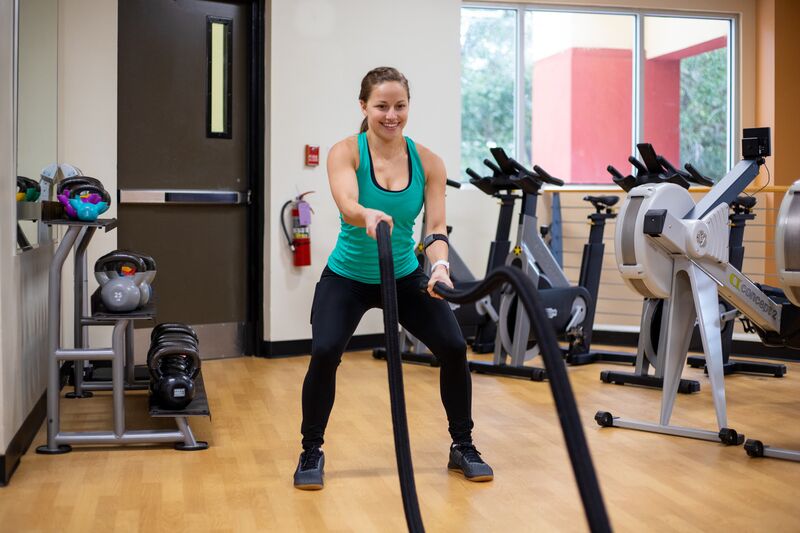The 8 Colors of Fitness program was developed to help you understand the ways your mind and body respond to exercising. Other exercise programs may start with a fitness plan and don’t consider your unique requirements. With this program, you start by understanding your fitness personality. After you take the quiz, read about the barriers of your color below. This knowledge will help you make better fitness choices for your personality and take the physical activity from boredom to enjoyment.
Blue
- Gather information from experts to establish the importance of physical activity.
- Take steps to assure safety and avoid injury. Check equipment, and review techniques and routines with professionals.
- Choose a fitness center carefully, keeping in mind the need for calm and organization. Familiar paths and routes work best when exercising outdoors.
- Schedule exercise as an appointment and put it on the list.
- Create a separate environment. A smartphone or audiobook can help tune out distractions.
Gold
- Choose activities that are both proven and promise results.
- Break goals into smaller parts, and set a plan so you can enjoy completing each workout.
- Exercise at a consistent time when possible, keeping track of results.
- Use physical activity as a time to plan.
- Engage with activities that benefit both the mind and body.
White
- You like to organize into categories. Plan for cardio, stretching, and strength training.
- Accept unfinished workouts as better than no workouts; commit to just 10 minutes and pick up where you left off next time.
- Familiarize yourself with the fitness facility or environment before you actually go for a workout.
- Choose activities that are repetitive, providing refreshing and creative time alone.
- Choose activities that you can make routine and fit into the rhythm of your life.
Purple
- Visualize, plan ahead, and schedule. You don’t have to stick to your plan, but it’s difficult to move forward without one.
- Organize exercise into categories. For example, cardio, strength, and flexibility, light, moderate, and intense, or indoor and outdoor.
- Consult with a trainer to design a program for initial knowledge; develop your own routine from there.
- Avoid exercise that requires navigational skills. Purples can easily get lost, which creates anxiety and interferes with exercise.
- Maintain interest by ensuring variety within a routine, and rotate throughout the week.
Green
- Create time to be outdoors alone. Negotiate work and/or familial responsibilities to ensure that time.
- Share your love of the outdoors with children. Coach a team or play outside with them,
- Train for an outdoor challenge or meaningful activity by yourself. Don’t be pressured into being an exercise buddy.
- Enjoy nature in all its forms and at all times of day—don’t rule out the nighttime!
- Revisit favorite places. Enjoy noticing physical changes, both big and small.
Red
- Choose activities and sports that are fun and can be done with others and maintain a network of active people.
- Fill your phone with your favorite music to keep you moving, especially when exercising inside.
- Keep gear handy so you’ll be ready for action when an opportunity opens up.
- To avoid injury, resist your natural impulse to “leave it all on the field.” Go easy on yourself.
- If you use indoor equipment, find or move it near a window so you can enjoy views of nature and outdoor activity.
Saffron
- Notice the physical signs of inactivity such as aches, pains, stiffness, or soreness.
- Choose activities that allow you to focus on something else and get exercise along the way.
- Engage your fun and playful side. Avoid structured activities with rigid attendance requirements.
- To keep your energy up, use your favorite music when walking or running.
- Enjoy activities alongside others. With a comfortable person, light banter can provide just the right amount of engagement to spark your energy.
Silver
- Notice signs of inactivity, such as aches, pains, stiffness, or soreness. Activity helps relieve these symptoms.
- Don’t wait until conditions are perfect. Just begin your activity and see where it takes you. Once you start working out, you’re more likely to continue.
- It’s not about exercise. Disguise activity with something more appealing—make it part of something that’s enjoyable and engaging.
- Keep transitions and practical requirements minimal, and restrict decision points to a few. Don’t get sidetracked along the way. For example, go to the gym in workout clothes to avoid wasted time in the locker room.
- Choose activities that will provide an opportunity to explore and learn something new.
